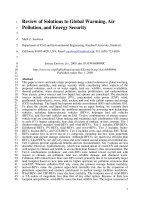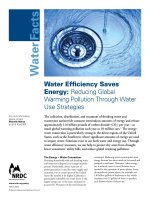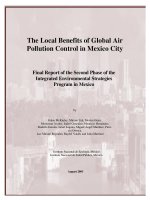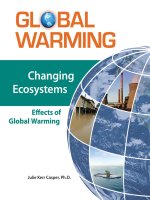Water Efficiency Saves Energy: Reducing Global Warming Pollution Through Water Use Strategies pot
Bạn đang xem bản rút gọn của tài liệu. Xem và tải ngay bản đầy đủ của tài liệu tại đây (763.09 KB, 4 trang )
Water Facts
Water Efficiency Saves
Energy: Reducing Global
Warming Pollution Through Water
Use Strategies
The collection, distribution, and treatment of drinking water and
wastewater nationwide consume tremendous amounts of energy and release
approximately 116 billion pounds of carbon dioxide (CO
2
) per year—as
much global warming pollution each year as 10 million cars.
1
The energy-
water connection is particularly strong in the driest regions of the United
States, such as the Southwest, where significant amounts of energy are used
to import water. Solutions exist to cut both water and energy use. Through
water efficiency measures, we can help to protect dry areas from drought,
lower consumers’ utility bills, and reduce global warming pollution.
For more information,
please contact
Michelle Mehta
at (310) 434-2300.
www.nrdc.org/policy
March 2009
© Natural Resources Defense Council
The Energy – Water Connection
Providing households with safe drinking water
and wastewater disposal is an energy-intensive
process. Nationwide, about 4 percent of
power generation is used for water supply and
treatment, but in certain parts of the United
States the number is far higher. California is
particularly vulnerable: the water sector is the
largest energy user in the state, estimated to
account for 19 percent of the total electricity
consumed. Reducing water consumption saves
energy because less water needs to be treated and
pumped to end users. Moreover, when energy
use is reduced, water is saved because less is
needed in the operation of power plants. Some
thermoelectric power plants, for example, use
136 billion gallons of freshwater a day, which
translates into 25 gallons of water to produce
each kilowatt-hour of electricity.
2
Source and Conveyance
1. Use Low Impact Development
(“Green” Building)
Capturing and reusing stormwater runoff can
greatly reduce the consumption of imported,
potable water, as well as the energy usage and
CO
2
emissions associated with importing water.
When runoff is diverted and captured before it
flows into surface waters, it can be used onsite
either to replenish groundwater supplies through
infiltration or for graywater uses, like landscape
irrigation and toilet flushing. These techniques
are known as low-impact development (LID),
the central objective of which is to maintain
individual sites’ pre-development hydrology. LID
uses common sense and simple technology—
strategically placed beds of native plants, rain
barrels, “green roofs,” porous surfaces for
parking lots and roads, and other measures—to
retain rainfall onsite or to help rainfall soak
into the ground, rather than polluting the
nearest receiving water. In effect, LID mimics
nature’s own filtration systems. In addition to
reducing water and energy use, the result is less
water pollution from contaminated runoff, less
flooding, replenished water supplies, and often
more natural-looking, aesthetically pleasing
cityscapes.
Water conservation and efficiency measures
reduce the burden on these energy-intensive
water systems. There are ways to cut down on
energy use—and greenhouse gas emissions—at
every stage in the water process:
NRDC Strategies for Saving Energy
Through Water Efficiency
The following series of policy recommendations
can help consumers, water suppliers and
distributors, farmers, and states conserve water
and in turn save energy. In many cases a single
investment will help conserve our water supply,
protect water quality, and lower energy demand,
which also results in economic savings, greater
sustainability of our water infrastructure, and a
reduction in global warming pollution.
Water Efficiency Saves
Energy: Reducing Global
Warming Pollution Through
Water Use Strategies
Water Facts
Source and
conveyance
Drinking
Water
Treatment
Distribution End use Wastewater
Treatment
Case Study: LID Can Save Water and
Energy in Southern California
LID’s benefits are particularly important in the
dry climates that characterize much of the
West, where rainfall is in short supply. Southern
California, for instance, must import most of its
water via the State Water Project, Colorado River
Aqueduct, and Los Angeles Aqueduct. Moving
such large quantities of water over long distances
and significant elevations requires a considerable
amount of energy. Widespread use of LID
practices would enable Southern California cities
to import significantly less water, in turn reducing
energy needs and associated CO
2
emissions. As
one example, if all new residential and commercial
development and redevelopment in urbanized
Southern California started using LID practices,
by 2030 CO
2
emissions would be reduced by up to
292,000 metric tons per year.
Intel's corporate headquarters in Santa Clara, California, incorporates LID techniques.
2. Recycle and Reuse
Wastewater
Because water suitable for reuse is often a
by-product of existing secondary and tertiary
wastewater treatment processes, this type of water
recycling is a low-energy source of water supply.
This is especially true in areas like Southern
California, where enormous amounts of energy
are required to import water. Recycled water
can be delivered to users, usually at less cost
than non-recycled water, for anything from
irrigating golf courses, parks, and crops, to
mixing concrete, to firefighting. In fact, Orange
County, California now uses advanced treatment
technologies to purify wastewater to beyond
bottled water quality, then allows it to percolate
into the groundwater basin for later use as
potable water. This system uses only about half
the energy that would be required to transport
that water from Northern California to Southern
California.
Distribution
3. Fix Leaking Drinking
Water Pipes
Water treatment processes use large quantities of
energy to treat and distribute water to customers.
Energy use for water treatment is expected to
increase as more stringent water quality rules
and improved disinfection technologies, such
as ultraviolet treatment and ozonation, are put
in place that reduce the risk of carcinogens
and other potentially harmful disinfection by-
products. Yet many drinking water systems lose
as much as 20 percent of treated drinking water
each year due to leaks in their pipe networks.
3
Improving drinking water infrastructure would
save water and energy, and reduce the global
warming pollution that results from wasted
energy.
End Use
4. Promote and Expand the
EPA’s WaterSense Program
The Environmental Protection Agency (EPA)
launched its WaterSense program in 2007 to
help consumers and businesses identify products
that meet the program’s water-efficiency
and performance criteria. The program sets
specifications for the labeling of products that
are at least 20 percent more efficient than the
current standards while performing as well or
better than their less-efficient counterparts.
All water savings realized through the use of
WaterSense-labeled products and services also
have a corresponding reduction in energy
consumption. The EPA estimates that if just one
out of every 100 American homes were retrofitted
with water-efficient fixtures, about 100 million
kilowatt-hours of electricity per year would be
saved—avoiding 80,000 tons of global warming
pollution, or the equivalent of over 8 million
gallons of gasoline consumption.
Local and federal government can expand
and promote the WaterSense program by:
n
Offering rebates for the purchase of WaterSense
products, as some cities are already doing.
n
Offering federal tax credits for purchasing
WaterSense products, as for the Energy Star
program.
n
Requiring WaterSense products in new
construction and in government buildings.
5. Require and Provide Incentives
for Agricultural Water-Use Efficiency
and Soil and Manure Management
Agriculture is a major user of groundwater and
surface water in the United States, accounting for
about 85 percent of the country’s consumptive
water use.
U.S. Consumptive Water Use
You Can Save Water and
Energy with WaterSense
Consumers
can save
both water
and energy
costs by
switching to
WaterSense-
labeled fixtures
and appliances, including
toilets, showerheads, faucets,
clothes washers, dishwashers,
and irrigation equipment. For
instance, the average household
could save more than 11,000
gallons of water, and about $170
on its water bill, every year by
making a few simple changes
such as installing WaterSense-
labeled toilets and faucets in
the bathroom. If just 1 percent
of American homes replaced
an older toilet with a new water
efficient toilet, the country
would save more than 38 million
kilowatt-hours of electricity—
enough electricity to supply more
than 43,000 households for a
month.
4
Domestic-Commercial 8%
Industrial Mining 4%
Thermoelectric 3%
Irrigation-
Livestock 85%
Water use efficiency measures such as
modest crop shifting, smart irrigation scheduling,
advanced irrigation management, and efficient
irrigation technology have the potential of vastly
improving water use efficiency. Switching from
flood irrigation to drip irrigation, for instance,
can increase water use efficiency as much as 40
percent. Even small management changes can
bring a 10 to 15 percent improvement in water
use efficiency. Less water pumped for agricultural
purposes equals energy savings and global
warming pollution reduction.
Global warming pollution can also be
reduced by improved agricultural soil and
manure management, which produces important
water quality benefits as well. According to
recent estimates, agriculture accounts for about
6 percent of all global warming pollution in
the United States. Nitrous oxide is the most
significant greenhouse gas emitted through
agricultural production. Agricultural soil
management activities account for 78 percent
of nitrous oxide emissions, most of which result
from the application of nitrogen fertilizers to
cropland, which in turn causes water pollution.
Currently, U.S. farmers apply about 20 to 30
percent more nitrogen fertilizer than needed.
Scientists further estimate that reducing nitrogen
fertilizer use would reduce downstream water
pollution by more than 20 to 30 percent.
5
Proven
nutrient conservation practices are available that
can substantially reduce loss of nitrogen to the
atmosphere and to surface and groundwater.
Wastewater and Drinking
Water Treatment
6. Implement Energy Conservation
Measures at Drinking Water and Wastewater
Treatment Facilities
Facilities that treat and distribute drinking
water and collect and treat wastewater have the
potential to achieve 15 to 30 percent energy
savings, or 15.75 to 31.5 billion kilowatt-hours,
through energy conservation measures alone.
6
Technology is currently available to improve
energy efficiency of equipment such as motors,
drives, and fans, by up to 50 percent for some
individual parts. Given that water and wastewater
facilities are often the largest and most energy-
intensive loads owned and operated by local
governments, representing up to 35 percent of
municipal energy use, water resources agencies
and energy commissions should work together
to reflect water-energy connections. For instance,
the non-profit Consortium for Energy Efficiency
has launched the National Municipal Water
and Wastewater Facility Initiative, which brings
together municipalities, counties, water districts
or authorities, and townships to promote greater
energy efficiency in publicly held facilities.
7. Retrofit Wastewater Facilities to Generate
Energy from Capture and Use of Biogas
Another way to save energy in the water supply
process is by retrofitting wastewater facilities with
Combined Heat and Power (CHP) systems. CHP
systems can recover biogas (a mixture of methane,
carbon dioxide, water vapor, and other gases)
from anaerobic digesters to heat buildings or to
generate electricity. For example, San Francisco’s
East Bay Municipal Utility District captures
and uses biogas to generate enough electricity
to cover 90 percent of energy needed at its main
wastewater facility. It is estimated that if all 544
large sewage treatment plants in the United States
operating anaerobic digesters were to install CHP
systems, about 340 megawatts of clean energy
could be generated, offsetting 2.3 million metric
tons of CO
2
emissions annually—equivalent to
planting about 640,000 acres of forest, or the
emissions of about 430,000 cars.
7
Water Efficiency Saves Energy
U.S. cities, particularly those in the arid
Southwest, continue to struggle to find fresh
water. At the same time, these cities are on the
front lines for feeling the impacts of global
warming, such as higher temperatures and
prolonged droughts. These water use efficiency
measures can be implemented by consumers and
agencies alike, saving both water and energy and
mitigating global warming pollution. It is clearly
a win-win solution.
Water Facts
www.nrdc.org/policy © Natural Resources Defense Council March 2009
Printed on recycled paper
Water Efficiency Saves
Energy: Reducing Global
Warming Pollution Through
Water Use Strategies
1
EPA, National Water Program Strategy:
Response to Climate Change (2008), at 24-25,
at />strategy.html. Much of the information in this
fact sheet has been adapted from this report.
2
U.S. Dept. of Energy, Energy Demands on
Water Resources (2006), at 18, at http://
www.sandia.gov/energy-water/docs/121-
RptToCongress-EWwEIAcomments-FINAL.pdf.
3
Congressional Budget Office, Future
Investment in Drinking Water and Wastewater
Infrastructure (2002), at 8, at .
gov/ftpdocs/39xx/doc3983/11-18-WaterSystems.
pdf.
4
EPA, WaterSense program website, at http://
www.epa.gov/watersense/index.htm.
5
Millennium Ecosystem Assessment,
Ecosystems and Human Well-being: Policy
Responses (2003), at 302.
6
Consortium for Energy Efficiency, Initiative
Description: CEE National Municipal Water and
Wastewater Facility Initiative (2007), at 1, at
/>des.pdf.
7
EPA, Combined Heat and Power Partnership,
Opportunities for and Benefits of Combined Heat
and Power at Wastewater Treatment Facilities
(2007), at iii, at />documents/wwtf_opportunities.pdf.









